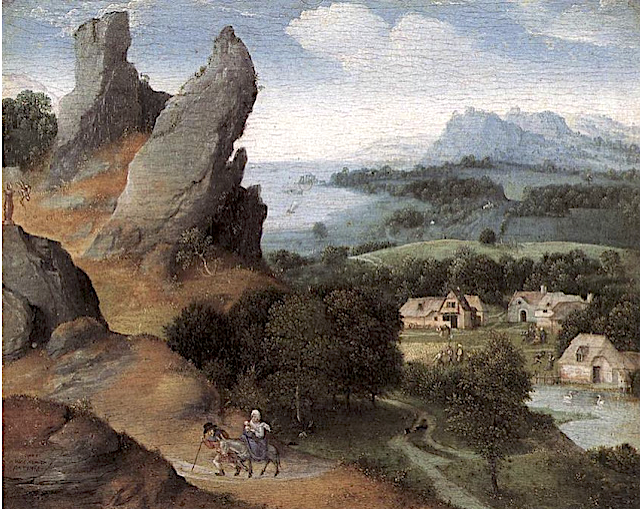A propos de la composition
Il s'agit évidement ici d'un Mont Sinaï imaginaire que l'on aperçoit à droite dans le loitain reproduit sur la foi de pèlerins de l'époque. Au cas où l'on aurait un doute, le petit village d'architecture flamande rassurerait tout de suite quant à la position géographique ! Ceci dit, hormis le ruisseau qui traverse ce désert du Sinaï plutôt hospitalier, la peinture des reliefs n'est pas si éloignée que cela de la réalité topographique.
Joachim Patinier, Patenier, ou Patinir, est un peintre et dessinateur flamand de la Haute Renaissance. Il intégra en 1515 la Guilde de Saint-Luc des peintres d'Anvers comme franc-maître et travailla en collaboration avec différents peintres dont Quentin Metsys. Ce dernier devait être assez intime avec lui puisqu'à sa mort, il fut désigné comme l'un des tuteurs de ses enfants. Lors de son voyage aux Pays-Bas, Albrecht Dürer se lia d'amitié avec Joachim Patinier et réalisa son portrait. C'est « un bon peintre de paysage » nota-t-il dans son journal de voyage. Il lui emprunta des couleurs, un de ses élèves, et assista à son second mariage le 5 mai 1521.
Considéré comme l'un des initiateurs du genre « paysage » dans la peinture occidentale, Joachim Patinier est un peintre d'histoire. Il réalisa des peintures à l'huile sur panneaux de bois dans le genre pictural majeur qui s’inspire surtout de scènes issues de l’histoire chrétienne popularisée par La Légende dorée de Jacques de Voragine. Son style est caractérisé par l'utilisation fréquente de la perspective atmosphérique qui offre une vision panoramique en plongée. Ses compositions comportent généralement trois plans principaux distincts : un premier plan brun sur lequel sont disposés les figures principales et leurs accessoires ainsi que des éléments minéraux et végétaux (des rochers, des herbes, des fleurs, un arbre ou un arbuste presque mort), un plan moyen à dominante verte où sont représentés avec finesse et précision de nombreux personnages vaquant aux occupations les plus diverses, et un arrière-plan aux reliefs remarquables d'un bleu intense — on parle parfois de « bleu Patinir » —, qui rejoignent un ciel nuageux de même tonalité dans lequel semble surgir un orage menaçant.
Joachim Patinier semble avoir eu recours à divers collaborateurs pour exécuter les figures de premier plan de bon nombre de ses tableaux. La manière de Joachim Patinier fut reprise par bon nombre de peintres de la même génération ou de la suivante, parmi lesquels on peut citer Joos van Cleve, Corneille Metsys, Lucas Gassel, Henri Bles et le Maître des demi-figures féminines. Les emprunts thématiques et stylistiques furent parfois si importants que de nombreuses œuvres de ces continuateurs furent confondues avec celles de Joachim Patinier lui-même.
Le mont est surtout célèbre dans le récit biblique pour avoir été le lieu où Moïse rencontra Dieu pour la première fois au buisson ardent (Ex 3,1-4,17) et où il reçut les Dix Commandements (ou Dix Paroles, en Ex 20,1-17) et de nombreuses autres lois pour le peuple hébreu (Exode 19,1-31,18). Plusieurs autres localisations de cet épisode ont été proposées (voir Har Karkom et Sinaï (Bible)).
Le mont Sinaï est situé au Nord-Est de l'Égypte, dans le gouvernorat du Sinaï Sud, au niveau de la pointe sud de la presqu’île du Sinaï, à 50 kilomètres des côtes de la Mer Rouge et d'El-Tor, au sud-ouest, ainsi qu'à 75 kilomètres de Charm el-Cheikh, au sud-sud-est, et 160 kilomètres environ à vol d'oiseau du Caire. Le sommet s'élève à 2 285 mètres d'altitude, à quatre kilomètres au nord-nord-est du mont Sainte-Catherine (2 642 m), point culminant du massif et du pays. Les roches du mont Sinaï sont issues de la phase tardive du bouclier arabo-nubien. Elles sont constituées de granite avec des intrusions de roches volcaniques incluant du porphyre. La montagne s'est soulevée de 140 à 65 millions d’années BP, au cours du Crétacé.Deux chemins principaux mènent au sommet. Le plus long et le moins escarpé s’appelle Siket El Bashait ; il faut environ deux heures et demie à pied pour la gravir mais il est accessible aux chameaux. L’autre itinéraire, appelé Siket Sayidna Musa, passe dans le ravin derrière le monastère et est surnommé la route aux 3 750 « pas de la pénitence ».
Dans un registre spirituel, la montagne est à plusieurs reprises citée par les théologiens sous l’appellation « Sinaï mystique », comme étant un rite d’initiation, consacrant une spiritualité ascendante devant mener à la découverte d’un « moi supérieur » situé en son sommet qui devient alors la symbolique du but à atteindre demeurant au cœur de nombreuses pratiques initiatiques d’inspiration chrétienne, chiite et soufie.
2023 - Gravir les montagnes en peinture
Un blog de Francis Rousseau




